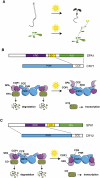Light-regulated interactions with SPA proteins underlie cryptochrome-mediated gene expression
- PMID: 21576261
- PMCID: PMC3093115
- DOI: 10.1101/gad.2053911
Light-regulated interactions with SPA proteins underlie cryptochrome-mediated gene expression
Abstract
Cryptochromes are a class of photosensory receptors that control important processes in animals and plants primarily by regulating gene expression. How photon absorption by cryptochromes leads to changes in gene expression has remained largely elusive. Three recent studies, including Lian and colleagues (pp. 1023-1028) and Liu and colleagues (pp. 1029-1034) in this issue of Genes & Development, demonstrate that the interaction of light-activated Arabidopsis cryptochromes with a class of regulatory components of E3 ubiquitin ligase complexes leads to environmentally controlled abundance of transcriptional regulators.
Figures

Comment on
-
Arabidopsis cryptochrome 1 interacts with SPA1 to suppress COP1 activity in response to blue light.Genes Dev. 2011 May 15;25(10):1029-34. doi: 10.1101/gad.2025011. Epub 2011 Apr 21. Genes Dev. 2011. PMID: 21511871 Free PMC article.
-
Blue-light-dependent interaction of cryptochrome 1 with SPA1 defines a dynamic signaling mechanism.Genes Dev. 2011 May 15;25(10):1023-8. doi: 10.1101/gad.2025111. Epub 2011 Apr 21. Genes Dev. 2011. PMID: 21511872 Free PMC article.
References
-
- Ahmad M, Cashmore AR 1993. HY4 gene of A. thaliana encodes a protein with characteristics of a blue-light photoreceptor. Nature 366: 162–166 - PubMed
-
- Balcerowicz M, Fittinghoff K, Wirthmueller L, Maier A, Fackendahl P, Fiene G, Koncz C, Hoecker U 2011. Light exposure of Arabidopsis seedlings causes rapid de-stabilization as well as selective post-translational inactivation of the repressor of photomorphogenesis SPA2. Plant J. 65: 712–723 - PubMed
-
- Busza A, Emery-Le M, Rosbash M, Emery P 2004. Roles of the two Drosophila CRYPTOCHROME structural domains in circadian photoreception. Science 304: 1503–1506 - PubMed
-
- Cashmore AR 2003. Cryptochromes: enabling plants and animals to determine circadian time. Cell 114: 537–543 - PubMed
-
- Chen H, Huang X, Gusmaroli G, Terzaghi W, Lau OS, Yanagawa Y, Zhang Y, Li J, Lee JH, Zhu D, et al. 2010. Arabidopsis CULLIN4-damaged DNA binding protein 1 interacts with CONSTITUTIVELY PHOTOMORPHOGENIC1-SUPPRESSOR OF PHYA complexes to regulate photomorphogenesis and flowering time. Plant Cell 22: 108–123 - PMC - PubMed
Publication types
MeSH terms
Substances
LinkOut - more resources
Full Text Sources
Miscellaneous
